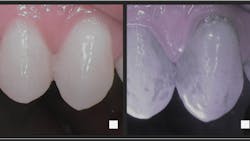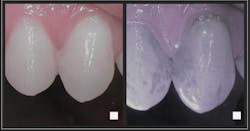How antibacterial photodynamic therapy improves oral health in patients with Sjögren’s syndrome
Sjögren’s syndrome and other autoimmune diseases negatively impact systemic health, causing xerostomia and other major oral health issues. Dry mouth symptoms associated with Sjögren’s syndrome increase the risk of tooth decay and fungal infections.1 When salivary secretion is reduced, even the best mechanical oral hygiene methods may not be enough to effectively prevent oral diseases. Regular at-home use of dual-light antibacterial photodynamic therapy (aPDT) can improve oral hygiene results, reducing the risk of developing oral diseases.2
Sjögren's syndrome is an autoimmune disease that affects the whole body—typically more women than men. In this condition, antibodies destroy salivary glands, which reduces saliva secretion. Reduced saliva production in turn increases the risk of developing oral diseases.
According to the National Sjögren’s Foundation, it is estimated that four million Americans are living with Sjögren’s syndrome.3 This makes it one of the most prevalent autoimmune diseases in the US.
You may also be interested in … Sjögren's syndrome: Considerations during and after cosmetic dentistry
Effects of antibacterial photodynamic therapy on oral health
Dr. Tommi Pätilä, a cardiac surgeon at the New Children’s Hospital of HUS in Finland and one of the scientists behind the development of a novel oral health solution based on aPDT (Lumoral), says, “Saliva effectively protects the teeth. When saliva secretion is impaired, tooth decay and damage to the supporting tissues of the teeth progress rapidly.”
In Sjögren's syndrome, it pays to invest in early oral care. Home-administered aPDT is a widely studied method that has been scientifically proven to reduce plaque in the mouth. It has also been shown to help treat inflammation and damage to periodontal tissues.2,4
User experience has shown that aPDT administered at home may also relieve dry mouth symptoms as it increases saliva secretion. However, more scientific evidence on its effect on saliva production is needed. New clinical studies on this topic are currently underway.
Dr. Pätilä says, “There is already a strong theoretical basis for this effect, which has been studied at Harvard University. The effect is called photobiomodulation, which is based on the action of cellular mitochondria on the tissues.”5
When brushing and flossing are not enough
Controlling oral biofilm, or plaque, is vital in preventing oral diseases such as gingivitis, periodontitis, and caries. Research has found that even a high-quality electric toothbrush removes only about 65% of harmful bacteria from the mouth.6 Residual plaque that remains irritates the gums, which increases the risk of oral diseases.
Lumoral is a health technology product with a medical device status for treating and preventing oral diseases at home. Many dentists and the Finnish Association of Dental Hygienists already recommend this new teeth-cleaning method, which improves traditional oral hygiene.7
“Home-applied aPDT kills both the bacteria that cause tooth decay, Streptococcus mutans, and the bacteria that cause gingivitis,” notes Dr. Pätilä.
The novel antibacterial oral health solution is primarily intended for people who do not get the desired results from conventional oral hygiene methods. These include individuals with chronic periodontal disease, older people, and those with an increased risk of tooth decay and gum disease, including those with autoimmune conditions such as Sjögren’s syndrome.2,4
Saliva: A crucial defense mechanism in the mouth
Dr. Jukka Meurman, professor emeritus of oral and maxillofacial diseases at the University of Helsinki, emphasizes that a careful oral hygiene routine is vital when a person has an underlying disease. At their worst, patients with Sjögren’s suffer from tremendously difficult dry mouth symptoms, making it difficult to speak and even swallow without saliva. Fortunately, cases this severe are rare; however, many other rheumatic diseases also have similar symptoms to Sjögren’s.
Saliva is a crucial defense mechanism in the mouth; no one should have to live without it. Drinking enough water (at least 1–1.5 liters per day for adults), using topical dry mouth products (available OTC), and rinsing the mouth with cooking oil (such as olive oil) are some traditional methods that have been used to relieve symptoms of xerostomia.
You may also be interested in … Oral-systemic health: Effects on athletic performance
Professor Meurman says antibacterial treatment administered at home is an excellent aid in preventing and relieving dental diseases and ailments. “Sjögren’s patients, if any, should add regular antibacterial aPDT to their oral hygiene routine to enhance the effects of brushing and flossing. Because reduced saliva secretion predisposes them to oral health problems, they should also receive dental care and checkups more frequently than usual—in the most severe cases, up to four times a year,” he advises.
A healthy mouth, in a healthy body
Professor Meurman stresses that oral health is directly linked to overall health. “The ulcerated gum provides a direct pathway for bacteria in the mouth to enter the rest of the body. Oral diseases are linked to more than 200 common diseases, including cardiovascular disease and diabetes. Oral health is directly related to the well-being of the body and the whole of human life in many ways, including social relationships, sleep, nutrition, exercise, and mental health.”
Infections of the mouth and teeth are, unfortunately, often the cause of the spread of microbes throughout the body via the bloodstream. While many people still do not fully understand the oral-systemic link, Dr. Pätilä says more and more dental and medical providers are emphasizing the close link between oral and general health and stressing the importance of oral disease prevention to their patients.
Preventing oral diseases increases the quality of life, but its costs are significant. According to Finland's Sjögren’s Patients’ Association, the cost of oral care for people with Sjögren's syndrome was more than 30% higher than the average cost of dental care for Finns in 2019.8 Prices have risen steadily throughout the 2000s.
Dr. Pätilä says a key reason for the high costs is that many people with Sjögren’s must resort to private dental care due to their increased risk of oral diseases. Higher costs lead to a greater need for treatment since many people delay seeking professional dental treatment.
Editor’s note: This article first appeared in Through the Loupes newsletter, a publication of the Endeavor Business Media Dental Group. Read more articles and subscribe to Through the Loupes.
References
- Maeshima E, Furukawa K, Maeshima S, Koshiba H, Sakamoto W. Hyposalivation in autoimmune diseases. Rheumatol Int. 2013;33(12):3079-3082. doi:10.1007/s00296-012-2611-1
- Pakarinen S, Saarela RKT, Välimaa H, et al. Home-applied dual-light photodynamic therapy in the treatment of stable chronic periodontitis (HOPE-CP)—three-month interim results. Dent J (Basel). 2022;10(11):206. doi:10.3390/dj10110206
- Understanding Sjögren’s. Sjögren’s Foundation. https://sjogrens.org/understanding-sjogrens
- Trujillo K, Räisänen IT, Sorsa T, Pätilä T. Repeated daily use of dual-light antibacterial photodynamic therapy in periodontal disease—a case report. Dent J (Basel). 2022;10(9):163. doi:10.3390/dj10090163
- Asan MF, Babu GS, Castelino RL, Rao K, Pandita V. Applications of photobiomodulation therapy in oral medicine—a review. Eur J Therapeutics. 2021;27(2):177-182. doi:10.5152/eurjther.2021.20080
- The Finnish Oral Hygiene Association recommends Lumoral. Finnish Association of Dental Hygienists. September 1, 2022. https://www.suuhygienistiliitto.fi/suomen-suuhygienistiliitto-suosittelee-lumoralia/
- Aggarwal N, Gupta S, Grover R, Sadana G, Bansal K. Plaque removal efficacy of different toothbrushes: a comparative study. Int J Clin Pediatr Dent. 2019;12(5):385-390. doi:10.5005/jp-journals-10005-1669
- Sjögrenliitto’s report on oral care costs. Finland’s Sjögren’s Patients’ Association. https://acrobat.adobe.com/link/review?uri=urn:aaid:scds:US:fb75d3ab-801c-3c82-945a-546f4780b9e1 (English) https://www.sjogrenliitto.fi/site/assets/files/1316/sjogrenliiton_selvitys_suunhoidon_kustannuksista_pakattu.pdf (Finnish)
About the Author

Nina Garlo-Melkas, MSc
Nina Garlo-Melkas, MSc, is a health and science journalist.



